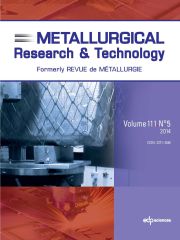Article contents
Thermodynamics of vaporization and condensation phenomena in vacuum furnaces used for casting superalloys
Published online by Cambridge University Press: 27 March 2003
Abstract
A thermodynamic approach has been used to progress in the understanding of the chemical processes taking place in the casting furnaces. The ceramic mould materials used for the casting of superalloys vaporize at high temperature under vacuum and the vapors condense then in the colder zones of the furnace. In addition, the graphite of the furnace resistor perturbs the vaporization regime of the moulds and is at the origin of other vaporization and condensation processes. The deposition regime of impurities leading to inclusions formation during the casting of the metal is modified. The thermodynamic analysis is confirmed by observations made on the superalloy casting furnaces. The deposits observed and characterized correspond to those predicted by the thermodynamic analysis, but the mass losses of the moulds producing these deposits are 60 times smaller than predicted.
- Type
- Research Article
- Information
- Metallurgical Research & Technology , Volume 100 , Issue 2: Science et Génie des MatériauxJournée Jean Morlet : J.A. SF2M 2001 , February 2003 , pp. 141 - 156
- Copyright
- © La Revue de Métallurgie, 2003
- 7
- Cited by


